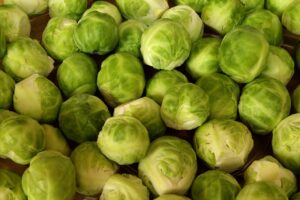Have you ever thought about the joy of harvesting your own vegetables from your backyard? Learning how to grow Brussels sprouts offers such pleasure, and more! This hardy vegetable that thrives in cooler weather could be your next gardening adventure.
Introduction
Brussels sprouts, a member of the Gemmifera Group of cabbages, are renowned for their exceptional nutritional profile and health benefits. Originally cultivated in Belgium—hence the name—these cruciferous vegetables are packed with vitamins and minerals. They are particularly high in vitamins C and K, offering potent antioxidant and anti-inflammatory benefits. Furthermore, they’re a great source of dietary fiber, which supports digestive health. Their high nutrient content combines with their low-calorie count, making Brussels sprouts a popular choice amongst health-conscious individuals and dietitians. Consuming them regularly can contribute to a healthy diet and assist in warding off various health issues.
Selecting the Right Variety
Brussels sprouts come in a variety of types, each offering its own unique characteristics.
- ‘Long Island Improved’: This is the classic green Brussels sprouts most people are familiar with. They’re highly disease-resistant and produce a high yield, making them an ideal choice for beginners.
- ‘Red Bull’: As the name suggests, this variety has a red hue, adding an interesting color contrast to your vegetable garden. They’re sweet, and tender, and hold their color even after cooking.
- ‘Churchill’: These are early maturing sprouts, ready for harvest in just 90 days. They have a compact size and offer a rich, sweet flavor.
- ‘Bubbles’: This is another early-maturing variety known for its high yields. ‘Bubbles’ has a fantastic flavor and is resistant to multiple common diseases.
- ‘Trafalgar’: This variety is known for its big, firm sprouts and excellent flavor. It’s a mid to late-season variety, making it perfect for a Thanksgiving or Christmas harvest.
Remember, your choice of variety can significantly influence your growing experience and the taste of your Brussels sprouts.
When choosing the right variety of Brussels sprouts, it’s important to consider several factors.
- Climate & Season: Some varieties thrive in cooler climates, while others prefer a warmer environment. Likewise, some are early maturing and suitable for a summer harvest, while others are late maturing, well-suited for a holiday harvest.
- The best variety for warmer areas is ‘Long Island Improved’.
- The best variety for cooler areas is ‘Bubbles’.
- Early-maturing varieties include ‘Churchill’, ‘Red Bull’, and ‘Bubbles’, while mid-to-late season varieties include ‘Trafalgar’ and ’Long Island Improved’.
- Disease Resistance: Certain types are more resistant to common diseases affecting Brussels sprouts, which can ease the cultivation process, particularly for novice gardeners.
- Yield: The yield of each variety may vary. If you’re growing Brussels sprouts for a large family or planning to store them, consider a high-yielding variety.
- Flavor & Color: If you’re growing for culinary purposes, the flavor and color of the sprouts are essential considerations. Some varieties are sweeter, while others offer a more robust flavor. Similarly, the color can add an interesting visual dimension to your dishes.
Remember, your local nursery or extension service can provide invaluable advice tailored to your specific region and needs.
Preparing the Soil
Brussels sprouts thrive in fertile, well-drained soil that is rich in organic matter. A pH level of 6.0-7.5 is optimal for these plants, promoting nutrient absorption and overall health. Before planting, it’s advisable to enrich your soil with compost or a slow-release fertilizer to ensure a steady supply of nutrients throughout the growing season. Be sure to avoid waterlogged soil conditions, as this can lead to root diseases. These plants also prefer full sun exposure, so choose a location that receives at least 6 hours of sunlight daily. Remember, a well-prepared soil can significantly impact your sprouts’ growth and flavor, so it’s worth investing the time to get it right.
Preparing the Planting Bed
To prepare the planting bed for Brussels sprouts, start by removing any weeds or other debris from your chosen area. You’ll also want to till your soil to a depth of at least 12 inches to ensure your sprouts’ roots have plenty of room to grow. After tilling, spread a 2-3 inch layer of compost or well-rotted manure over the surface and work it into the top few inches of soil. This will help to improve the soil structure and provide a nutrient-rich environment for your plants to thrive. If your soil is particularly heavy or clay-like, consider adding some horticultural grit to improve drainage. Lastly, rake the soil to a fine tilth, creating a smooth and even surface that’s ready for planting. It’s best to prepare the planting bed a week or so before you intend to plant, giving the soil time to settle and the organic matter to start breaking down.
Planting Brussels Sprouts
When to Plant Brussels Sprouts
The ideal time to plant Brussels sprouts varies depending on your local climate and the specific variety of sprout you’re cultivating. Typically, these plants thrive in cooler temperatures, meaning early spring or late summer are often the best times to start your planting. If you’re planting in early spring, aim to get your seeds in the ground as soon as the soil can be worked, usually around 2-3 weeks before the last expected frost. For a late summer planting, aim to sow your seeds about 12-14 weeks before the first expected fall frost. This will allow the sprouts to mature in the cooler autumn climate, enhancing their flavor and sweetness. Always check the specific growing recommendations for your chosen variety, as some may have slightly different growing requirements.
How to Sow Seeds or Transplant Seedlings
Whether you’re starting from seed or transplanting seedlings, proper technique is crucial to ensure healthy growth. If you’re sowing seeds directly, plant them about ½ inch deep and 2-3 inches apart in rows that are 2-3 feet apart. Cover the seeds lightly with soil and water thoroughly.
If you’re transplanting seedlings, dig a hole deep enough to accommodate the root ball of your seedling, and wide enough to allow for root expansion. Space seedlings about 18-24 inches apart in rows that are 2-3 feet apart. Set the seedling in the hole, backfill with soil, and press lightly to eliminate air pockets. Water the seedlings thoroughly after transplanting.
Remember, Brussels sprouts prefer a sunny location with well-drained soil. Monitor water levels closely as your sprouts grow – they prefer consistently moist soil, but not waterlogged conditions.
Caring for Brussels Sprouts
Watering Requirements
Brussels sprouts have moderate watering needs – neither too much nor too less. The key is to keep the soil consistently moist. A deep, thorough watering once a week should be sufficient for most gardens, but this may need to increase during particularly hot or dry periods. Remember, it’s better to water deeply less frequently than to water shallowly more often as it encourages the roots to grow deeper into the soil. Also, watering in the early morning helps minimize evaporation, ensuring the water gets to the plant’s roots where it’s needed most. Be careful not to overwater, as waterlogged conditions can lead to root rot and other diseases. As always, it’s best to adjust your watering practices based on your specific soil and weather conditions.
Fertilizing Schedule
Feeding your Brussels sprouts with the right nutrients at the right time can significantly enhance their growth and yield. Start by applying a balanced, slow-release fertilizer at the time of planting. This will provide a constant nutrient supply as the plants establish themselves.
About a month after planting, when the plants are well-established, apply a high-nitrogen fertilizer to support leafy growth. This should be lightly worked into the soil around the base of the plants, taking care not to disturb the roots.
From then on, apply a balanced fertilizer every 4-6 weeks throughout the growing season. This will provide a steady supply of nutrients, promoting healthy growth and a plentiful harvest. As always, it’s important to follow the manufacturer’s instructions for application rates and to adjust your fertilizing practices based on your specific soil conditions.
Remember to end the fertilizing schedule about a month before the expected first frost date in your area. This allows the plants to harden off and prepare for winter. Always water thoroughly after applying fertilizer to help it reach the root zone where it’s most beneficial.
Disease and Pest Control
Pest and disease management is critical for maintaining a healthy Brussels sprout garden. Common pests such as aphids, cabbage loopers, and cutworms can harm your plants, while diseases like clubroot and black leg can be devastating. Implementing preventive measures can mitigate these risks.
To deter pests, consider using organic insecticides or introducing natural predators such as ladybugs into your garden. Regular inspection of your plants can also help identify pest infestation early, allowing for timely intervention.
To prevent diseases, practice crop rotation, as it disrupts the life cycle of disease-causing organisms. Also, ensure your plants have adequate spacing to promote air circulation, which can help prevent the onset of fungal diseases.
If a disease does take hold, it may be necessary to remove and destroy affected plants to prevent it from spreading. Always remember, a proactive approach to disease and pest control will result in a more productive and healthy garden.
Harvesting and Storing
Harvesting Brussels Sprouts
Brussels sprouts are usually ready to harvest when they are firm, green, and about 1-2 inches in diameter. Harvesting typically begins in the lower part of the stalk, as these sprouts mature first. To harvest, simply twist the sprout off the stalk or use a sharp knife to cut it off.
It’s best to harvest Brussels sprouts after a few frosts, as cold temperatures can enhance their sweetness. However, make sure to harvest all sprouts before the ground freezes solid. If sprouts are left on the stalk too long, they can become tough and bitter.
Storing Brussels Sprouts
Once harvested, Brussels sprouts can be stored in the refrigerator for about a week. Keep them in a plastic bag, but do not wash them until you are ready to use them, as moisture can lead to mold. For long-term storage, Brussels sprouts can be blanched and then frozen for up to one year.
Conclusion
Recap of Growing Brussels Sprouts
In summary, growing Brussels sprouts involves several stages. It begins with preparing the soil, ensuring it is well-drained and rich in organic matter. Next, comes the planting process, followed by regular watering and feeding. Crucially, keep a watchful eye on pest and disease prevention, implementing practices such as crop rotation and adequate plant spacing. Finally, the sprouts are ready to harvest when firm and green, and can be stored in the refrigerator for a week or frozen for up to a year.
Growing your own Brussels sprouts can be a rewarding endeavor. Not only does it provide you with a fresh, nutritious vegetable right at your fingertips, but it also offers a sense of fulfillment. So, why not give it a go? With patience, care, and a little bit of green thumb, you’ll be enjoying your homegrown Brussels sprouts in no time!


